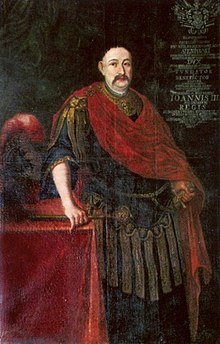Mikołaj Hieronim Sieniawski: Difference between revisions
Tags: nowiki added Visual edit |
m Added short description #article-add-desc Tags: Mobile edit Mobile app edit iOS app edit |
||
| (5 intermediate revisions by 5 users not shown) | |||
| Line 1: | Line 1: | ||
| ⚫ | |||
{{Infobox |
{{Infobox noble |
||
| name = Mikołaj Hieronim Sieniawski |
| name = Mikołaj Hieronim Sieniawski |
||
| image = Hieronim Mikołaj Sieniawski.jpg |
| image = Hieronim Mikołaj Sieniawski.jpg |
||
| Line 15: | Line 16: | ||
| death_place = |
| death_place = |
||
}} |
}} |
||
[[File:Saddle with shabrack according to tradition linked with Hetman Mikołaj Hieronim Sieniawski.jpg|thumb|[[Ottoman Empire|Ottoman]] saddle with [[shabrack]] according to tradition captured at [[Battle of Vienna|Vienna in 1683]] by the Mikołaj Hieronim Sieniawski, [[Czartoryski Museum]]]] |
|||
'''Mikołaj Hieronim Sieniawski''' (1645–1683) was a Polish [[Szlachta|noble]] (szlachcic), military leader and politician. |
|||
| ⚫ | |||
| ⚫ | |||
==Biography== |
|||
| ⚫ | |||
He was the son of the [[starost]] of [[Lwów]] [[Adam Hieronim Sieniawski (1623–1650)|Adam Hieronim Sieniawski]] and Wiktoria Elżbieta Potocka, the daughter of [[Hetman]] [[Stanisław "Rewera" Potocki]]. He married in 1662 the daughter of Court and Grand Marshal Prince [[Aleksander Ludwik Radziwiłł]], Princess Cecylia Maria Radziwiłł. |
He was the son of the [[starost]] of [[Lwów]] [[Adam Hieronim Sieniawski (1623–1650)|Adam Hieronim Sieniawski]] and Wiktoria Elżbieta Potocka, the daughter of [[Hetman]] [[Stanisław "Rewera" Potocki]]. He married in 1662 the daughter of Court and Grand Marshal Prince [[Aleksander Ludwik Radziwiłł]], Princess Cecylia Maria Radziwiłł. |
||
==Military career and politics== |
|||
He was [[Grand Guardian of the Crown]] since 1666, [[Great Chorąży of the Crown]] since 1668, [[Court Marshall of the Crown]] since 1676, starost of Lwów since 1679, [[voivode]] of [[Wołyń Voivodeship (1569–1795)|Volhynian Voivodship]] since 1679, Field Crown Hetman since 1682 and starost of [[Radom]], [[Rohatyn]], and [[Piaseczno]]. |
He was [[Grand Guardian of the Crown]] since 1666, [[Great Chorąży of the Crown]] since 1668, [[Court Marshall of the Crown]] since 1676, starost of Lwów since 1679, [[voivode]] of [[Wołyń Voivodeship (1569–1795)|Volhynian Voivodship]] since 1679, Field Crown Hetman since 1682 and starost of [[Radom]], [[Rohatyn]], and [[Piaseczno]]. |
||
He became famous as a talented commander in wars against [[Cossacks]] and [[Tatars]] during the reign of King [[John II Casimir]]. In the rank of a ''[[Chorąży]]'' he took part, alongside [[John III of Poland|John Sobieski]], in the [[Chocim]] expedition. |
He became famous as a talented commander in wars against [[Cossacks]] and [[Tatars]] during the reign of King [[John II Casimir]]. In the rank of a ''[[Chorąży]]'' he took part, alongside [[John III of Poland|John Sobieski]], in the [[Chocim]] expedition. |
||
He was [[Sejm Marshal|Marshal]] of the [[Coronation Sejm]] between 2 and 14 March 1676 in [[Kraków]]. |
He was [[Sejm Marshal|Marshal]] of the [[Coronation Sejm]] between 2 and 14 March 1676 in [[Kraków]]. |
||
Like his son [[Adam Mikołaj Sieniawski]], he participated in the [[Battle of Vienna|Vienna expedition]] of 1683. He died in the same year by contracting a disease, possibly [[syphilis]], that spread after the battle. |
Like his son [[Adam Mikołaj Sieniawski]], he participated in the [[Battle of Vienna|Vienna expedition]] of 1683. He died in the same year by contracting a disease, possibly [[syphilis]], that spread after the battle. {{Marshals CC}} |
||
<nowiki><gallery widths="180" heights="220" class="center"> </nowiki> |
|||
File:Mikałaj Hieranim Sianiaŭski. Мікалай Геранім Сяняўскі (XVII).jpg |
|||
File:Hieronim Mikołaj Sieniawski.jpg |
|||
File:Anonymous Adam Mikołaj Sieniawski.jpg |
|||
File:Portret Mikołaja Hieronima Sieniawskiego (1645-1683).jpg |
|||
File:Full 275.jpg |
|||
File:Portret Mikołaja Hieronima Sieniawskiego.jpg |
|||
File:Mikołaj-Hieronim Sieniawski.jpg |
|||
File:Mikołaj-Hieronim Sieniawski ZW.jpg |
|||
<nowiki></gallery></nowiki>{{Marshals CC}} |
|||
{{Hetmans FC}} |
{{Hetmans FC}} |
||
{{Sejm Marshals of the Polish-Lithuanian Commonwealth}} |
{{Sejm Marshals of the Polish-Lithuanian Commonwealth}} |
||
| Line 57: | Line 37: | ||
{{Authority control}} |
{{Authority control}} |
||
{{DEFAULTSORT:Sieniawski, Mikolaj Hieronim}} |
{{DEFAULTSORT:Sieniawski, Mikolaj Hieronim}} |
||
[[Category:Sieniawski family|Mikolaj Hieronim]] |
[[Category:Sieniawski family|Mikolaj Hieronim]] |
||
Latest revision as of 05:38, 14 July 2024
Mikołaj Hieronim Sieniawski | |
|---|---|
 | |
| Born | 1645 |
| Died | 15 December 1683 |

Mikołaj Hieronim Sieniawski (1645–1683) was a Polish noble (szlachcic), military leader and politician.
Early life and family
[edit]He was the son of the starost of Lwów Adam Hieronim Sieniawski and Wiktoria Elżbieta Potocka, the daughter of Hetman Stanisław "Rewera" Potocki. He married in 1662 the daughter of Court and Grand Marshal Prince Aleksander Ludwik Radziwiłł, Princess Cecylia Maria Radziwiłł.
Military career and politics
[edit]He was Grand Guardian of the Crown since 1666, Great Chorąży of the Crown since 1668, Court Marshall of the Crown since 1676, starost of Lwów since 1679, voivode of Volhynian Voivodship since 1679, Field Crown Hetman since 1682 and starost of Radom, Rohatyn, and Piaseczno.
He became famous as a talented commander in wars against Cossacks and Tatars during the reign of King John II Casimir. In the rank of a Chorąży he took part, alongside John Sobieski, in the Chocim expedition.
He was Marshal of the Coronation Sejm between 2 and 14 March 1676 in Kraków.
Like his son Adam Mikołaj Sieniawski, he participated in the Vienna expedition of 1683. He died in the same year by contracting a disease, possibly syphilis, that spread after the battle.

